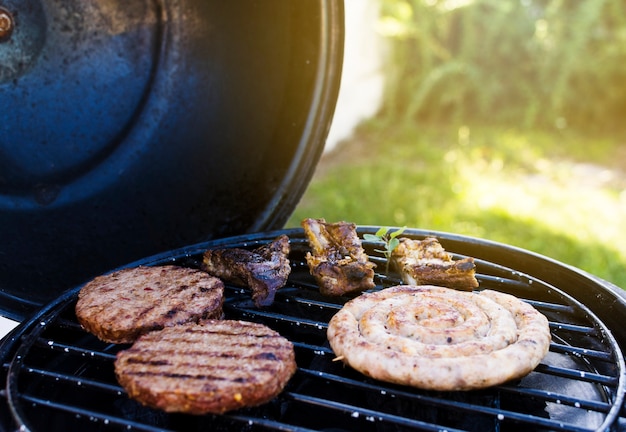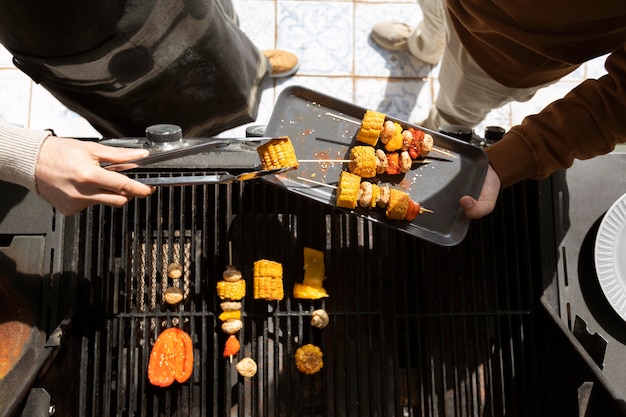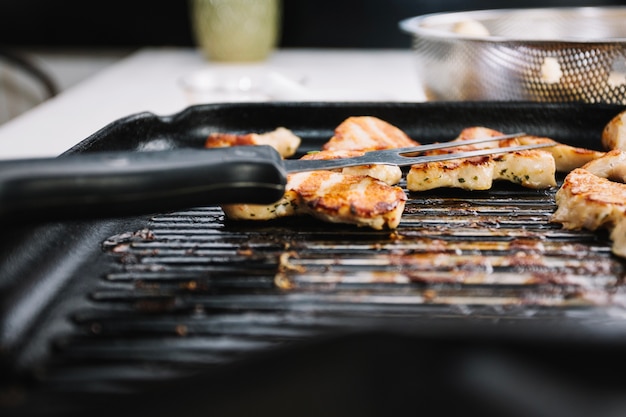(Part 1) The Cut: choosing the right steak for the Job

You can't just grab any old piece of meat and expect a fantastic steak. The right cut is essential for that mouth-watering marbling and tender texture. Sure, you can grill a tougher cut, but it takes more finesse and patience.
Here's my take on some of the best cuts for grilling:
The Classics:
- Rib-eye: The king of the grill, the rib-eye is known for its rich, buttery flavour and generous marbling. The "eye" of fat running through the centre adds a unique richness that melts in your mouth. It's a crowd-pleaser and perfect for a special occasion.
- new york strip: A bit leaner than the rib-eye, the New York strip offers a bold, beefy flavour with a good amount of marbling. It's perfect for grilling medium-rare, showcasing its tender texture and juicy character. It's a classic for any dinner party.
- filet mignon: This is the most tender cut of beef, known for its delicate flavour and buttery texture. It's often grilled to a medium-rare doneness to maintain its delicate tenderness. While more expensive, a filet mignon is a truly decadent treat for special occasions.
The Underdogs:
- Sirloin: Don't underestimate the sirloin! It's a versatile cut that can be grilled to a variety of doneness levels. It's a great option for budget-conscious cooks and is perfect for grilling over a medium heat. Its flavour is rich and satisfying, making it a fantastic choice for a casual weeknight meal.
- flank steak: This thin, long cut is best when marinated before grilling. The marbling is less prominent, but it develops a wonderful flavour with marinades. It's perfect for slicing thinly and serving with a salad or as part of a fajita platter.
Remember this:
When you're selecting your steak, look for cuts with good marbling – those streaks of fat are what give your steak its rich flavour and juicy tenderness. And don't be afraid to ask your butcher for recommendations – they're experts and can guide you to the perfect cut for your grilling needs.
(Part 2) Prep Work: Getting Your Steak Ready for the Grill

You've got your perfect cut, now it's time to prep it for the grill. It might seem straightforward, but these steps can make a huge difference in the final product.
1. Bring it to Room Temperature:
This crucial step is often overlooked. Avoid cooking a steak straight from the fridge, as it will cook unevenly. Instead, take your steak out of the fridge about 30 minutes before you plan to grill it. This allows the steak to come to room temperature, resulting in a more even cook and preventing the cold meat from shocking the hot grill.
2. Seasoning:
Here's where you can get creative! You can go with the classics like salt and pepper, or you can add some flavour with garlic powder, onion powder, paprika, or even a touch of chili powder. I prefer to use coarse salt and freshly ground black pepper – it's simple and lets the natural flavour of the steak shine through.
Pro tip: Season your steak generously on both sides, and make sure to season the edges too! It's a step most people skip, but it makes a noticeable difference in the final flavour profile.
3. Marinades (Optional):
Marinades are a fantastic way to add flavour and tenderize your steak, but they're not essential. If you decide to marinade, ensure you do it for at least an hour – preferably longer.
I have a few favourite marinade recipes, but I'll save those for another time. For now, just remember to use quality ingredients and ensure the marinade is properly balanced. You don't want it to be too acidic; otherwise, it will start to break down the steak.
(Part 3) Firing Up the Grill: The Art of Heat Control

Now comes the fun part – firing up the grill! Getting the heat right is absolutely crucial for a perfect steak. If it's too hot, you'll end up with a charred exterior and a raw centre. If it's too low, you'll get a tough, dry steak.
1. Gas or Charcoal?
Personally, I prefer to grill over charcoal. It adds a unique smoky flavour that you just can't get from a gas grill. However, both types have their pros and cons.
Gas Grills: Easier to control temperature, consistent heat, quicker to heat up. They are ideal for beginners and those looking for a less hands-on experience.
charcoal grills: More intense and smoky flavour, hotter temperatures for a great sear. They require more effort and time, but the smoky flavour they impart is unparalleled.
2. Getting the Grill Ready:
If you're using charcoal, ensure you have enough coals to create a good bed of heat. For gas grills, preheat the grill to medium-high heat.
Pro tip: If you're using a gas grill, you can use the "two-zone" method to control the heat. Just heat one side of the grill to high heat and the other side to medium-low heat. This allows you to sear the steak on the high side and then move it to the lower side to finish cooking.
(Part 4) The Sear: Creating a Crust to Remember
Now, here's where things get exciting! The sear is what gives your steak that delicious crust and adds a smoky depth of flavour.
1. Get the grill nice and hot. Aim for a temperature of around 450-500°F. You want to see those coals glowing red hot, or the gas grill roaring away.
2. Place your steak on the grill and don't touch it! The first few minutes are crucial for creating a beautiful sear. Resist the urge to flip it too soon.
3. Let the steak sit for about 2-3 minutes on each side. You should see nice, dark grill marks forming.
4. Flip the steak over and repeat the process on the other side.
Pro tip: Don't overcrowd the grill. If you have multiple steaks, cook them in batches to ensure they get a good sear on all sides. This helps maintain the optimal heat and prevents the steaks from steaming instead of searing.
(Part 5) The Cook: Finding the Perfect Doneness
Once you've got your beautiful sear, it's time to focus on cooking the steak to your preferred doneness.
1. Temperature Check:
The most reliable way to check the internal temperature of the steak is to use a meat thermometer. Here are the recommended internal temperatures for different levels of doneness:
| Doneness | Internal Temperature (°F) |
|---|---|
| Rare | 125-130 |
| Medium-Rare | 130-135 |
| Medium | 140-145 |
| Medium-Well | 150-155 |
| Well-Done | 160 |
2. The "Finger Test" (for the Brave):
If you're feeling adventurous, you can use the "finger test" to estimate the doneness of your steak. Press your finger into the palm of your hand – the fleshy part below your thumb. That's the feeling of a rare steak. Now, press the same spot on the back of your hand – that's medium-rare. The more firm the feel, the closer you are to well-done.
3. Resting Time:
After you've cooked your steak to the desired doneness, it's essential to let it rest for at least 5-10 minutes before slicing and serving. This allows the juices to redistribute throughout the steak, resulting in a more tender and flavorful final product. The internal temperature will also continue to rise slightly during this rest period, ensuring the steak reaches your desired doneness.
(Part 6) The Finishing Touches: Elevating Your Steak Game
You've got the perfect sear, the perfect doneness, and now you're ready to take your steak to the next level.
1. Compound Butter:
A compound butter is a simple way to add a burst of flavour to your steak. Just mix softened butter with herbs, spices, garlic, or even a bit of lemon zest. Spread the compound butter over the steak before serving. My favourite is a garlic and herb butter. It adds a delicious aroma and a burst of flavour that complements the rich beef perfectly.
2. Sauces:
A good sauce can really elevate your steak. You can go for a classic like Béarnaise or peppercorn sauce, or you can get creative with a chimichurri or a balsamic glaze. I personally love a simple pan sauce made with the drippings from the steak. The rich, flavorful pan sauce adds another dimension to the steak, creating a well-rounded and satisfying dish.
3. Sides:
Don't forget about your sides! A great steak deserves a great accompaniment. I like to serve my steak with a simple salad, roasted vegetables, or a hearty potato dish. For a more balanced meal, choose sides that complement the flavour and richness of the steak.
(Part 7) Troubleshooting: When Things Don't Go as Planned
Okay, so we've covered the basics, but what if something goes wrong? What if your steak is too tough or too dry? Don't panic! Here are a few tips to help you salvage the situation:
1. Tough Steak:
If your steak is tough, you may have overcooked it. Next time, try cooking it for a shorter period or using a lower heat. If you've already cooked it, you can try to tenderize it by slicing it thinly and serving it with a sauce. This will help to break up the tough fibers and make the steak more palatable.
2. Dry Steak:
A dry steak is often a result of overcooking. Try to cook your steak to a lower doneness, and be sure to rest it for at least 5-10 minutes before serving. The resting time will allow the juices to redistribute, resulting in a more moist and flavorful steak.
(Part 8) Beyond the Basics: Exploring New Flavours and Techniques
Alright, so you've mastered the basic techniques of grilling a steak. But, if you're feeling adventurous, there are endless possibilities for exploring new flavours and techniques.
1. reverse searing:
Reverse searing is a technique where you cook the steak to the desired doneness in a low oven before finishing it with a quick sear on the grill. This method results in a more evenly cooked steak with a juicy centre and a delicious crust. The oven cooking allows the steak to cook slowly and evenly, resulting in a more tender and juicy steak. The final sear on the grill adds that signature crust and smoky flavour.
2. Wood-Fired Grilling:
For a truly unique flavour, try grilling your steak over wood chips or planks. Oak, hickory, and mesquite are popular choices. These woods impart a distinct smoky flavour to the steak, adding another layer of complexity and depth to its flavour.
3. Experiment with Different Marinades and Rubs:
Get creative and try out different flavour combinations. Some popular choices include a soy-ginger marinade, a lemon-herb rub, or a dry rub with paprika, cumin, and chili powder. Explore different cultures and flavour profiles to find your personal favourite.
FAQs
Q: How do I know when my steak is cooked to the right doneness?
A: The best way to check the doneness of your steak is to use a meat thermometer. It's the most accurate and reliable method to ensure your steak is cooked to your preference. You can also use the "finger test," but it's not as accurate. If you're unsure, it's always better to err on the side of undercooking. You can always cook it a bit more, but you can't undo overcooking.
Q: What if my steak is too thin?
A: If your steak is too thin, it's best to cook it on a medium-low heat to avoid overcooking. You can also try using the reverse searing technique. This will allow the steak to cook evenly without drying out.
Q: What if my steak is too thick?
A: If your steak is too thick, you may need to cook it for a longer period or use a higher heat. You can also try using the reverse searing technique. This will allow you to cook the steak evenly without overcooking the outside while the centre remains raw.
Q: How do I clean my grill after grilling a steak?
A: For charcoal grills, let the coals cool completely before removing them. For gas grills, use a grill brush to remove any food particles. A clean grill is essential for future grilling sessions, preventing the buildup of food and grease that can affect flavour and heat distribution.
Q: What are some good side dishes to serve with steak?
A: There are endless possibilities for side dishes to serve with steak. Some popular choices include roasted vegetables, potato salad, mac and cheese, asparagus, and grilled corn on the cob. Choose sides that complement the flavour of the steak and provide a balanced meal.
Remember, grilling a steak is all about experimenting and finding what works best for you. So, don't be afraid to try different techniques and flavour combinations. And most importantly, have fun! You've got this.
Everyone is watching

How to Cook Frozen Lobster Tails Perfectly: A Step-by-Step Guide
RecipesLobster. Just the word conjures up images of lavish meals, special occasions, and a taste of luxury. But let's...

Pigs in a Blanket Cooking Time: How Long to Bake for Perfect Results
RecipesAh, pigs in a blanket. Just the name conjures up images of those delightful little parcels of crispy pastry en...

Pork Fillet Cooking Time: How Long to Cook It Perfectly
RecipesPork fillet, or tenderloin as it's sometimes called, is a real favourite in our house. It's so versatile, and...

The Ultimate Guide to Tender, Juicy Pulled Pork
RecipesRight, let's talk pulled pork. It's one of those dishes that just screams "comfort food," doesn't it? I mean...

The Ultimate Guide to Cooking Sweet Potatoes: From Roasting to Mashing
RecipesSweet potatoes. Just the name conjures up images of warm, comforting dishes, bursts of vibrant color, and a to...
